Will the Howard Theatre go the same way as the Lincoln Theatre?
Will the Howard Theatre, soon to open in April, end up bankrupt like the Lincoln Theatre on U Street? Both are historic U Street area theaters that were revived at significant public expense. Both are owned by the District government and are under the control of non-profits.
There are, however, some significant differences between the Lincoln and the Howard: the floor, the kitchen, and the management.
The Lincoln Theatre is a traditional theater with fixed rows of seats. This makes the venue unsuitable for a variety of performances. All concert venues nearby have few if any seats— just an open floor where patrons stand.
The Howard Theatre’s floor is a little different. The theatre will have few permanent seats. Much of the space will contain seats and tables for the performances where food is served, such as the weekly gospel brunch, a comedy show, or certain jazz performances.
When tables are unsuitable for the type of performance, they will be stowed beneath the stage, thus opening up the first floor like the 9:30 Club or the Black Cat. This flexibility allows the venue to attract a greater variety of acts.
Another important difference is that the Howard Theatre will contain a large kitchen. Food service, particularly on the sale of alcohol, is where the venue will make money. The Lincoln Theatre’s food and liquor operation can’t compare.
Finally, while the Lincoln Theatre was managed (or mismanaged, some say) by an ad hoc non-profit, the Howard Theatre will be run by Blue Note Jazz Clubs, which runs the Blue Note Jazz Club, the Highline Ballroom, and B.B. King Blues Club & Grill in New York. This gives us confidence that a similar success can happen at the Howard.
The Howard Theatre and the value of public investment
The Howard Theatre’s renovation, in which the District government invested $12 million, got us thinking about the role of public finance in development projects. The use of public money or, alternatively, the granting of tax abatements to private projects, elicits controversy. Opponents argue that such investments are give-aways to well-connected businessmen.
 In the case of the Howard Theatre, the District’s investment in the venue, which the District government technically owns, is a good investment that is economically justified. The new venue and streetscape in front will improve the perception of the area and thus improve property values in LeDroit Park. The former is an improvement to the quality of life while the latter is an improvement to the District’s tax base.
In the case of the Howard Theatre, the District’s investment in the venue, which the District government technically owns, is a good investment that is economically justified. The new venue and streetscape in front will improve the perception of the area and thus improve property values in LeDroit Park. The former is an improvement to the quality of life while the latter is an improvement to the District’s tax base.
Though the theater is technically just outside LeDroit Park, the path from the Shaw Metro Station to LeDroit Park typically brings people in front of the theater. When the District-owned theater was decaying and vacant, it served as an awful first impression of the area. A barbed wire fence under the awning and marquee made visitors well aware that a strong wind gust could cause the awning to collapse. The heaps of litter and scurrying of rats certainly didn’t help perceptions, either.
Work crews are reconstructing the entire street, including sidewalks and lamp posts, and when the renovated theater opens next month, much of the former blight will be removed. Smooth, wheelchair-accessible sidewalks will replace broken concrete. Lamp posts will provide ample light. A statue on the sidewalk and a statue atop the theatre will add to the sense of place for this important historic venue.
The theater itself, renovated and gleaming, will attract patrons several nights a week and the building will have to remain in good order. Clean surfaces and façade adornments will replace trash, decay, and danger. The block will be unrecognizable from before.
These improvements will undoubtedly improve how visitors and residents view the block and perhaps how they view LeDroit Park. The quality of life improvements are certain. From a financial standpoint, the improvements will likely boost surrounding property values and thus property tax revenues for the District. In doing so, the additional revenue may far exceed the $12 million of public money invested in the site.
Correction: An earlier version of this post understated the dollar amount of the city’s investment.
Howard Theatre planning a busy April
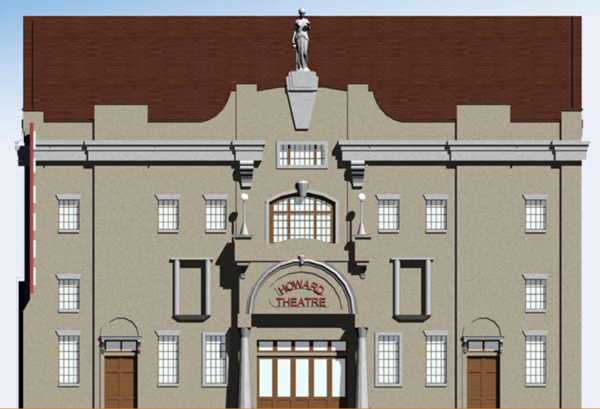
What do Wale, Wanda Sykes, the Roots, Esperanza Spalding, and Chuck Berry have in common? They are all performing at the Howard Theatre in April. Also, each Sunday the theatre will host a gospel brunch and gospel choir.
T Street renovations reveal old streetcar tracks
The Howard Theatre is set to open in April. While construction crews are finishing the theater’s historic restoration, the District government is renovating the entire street in front of the theater. The streetscape project involves replacing the sidewalks, curbs, road pavement, storm drains, and lamp posts on the 600 block of T Street NW and along the one-block Wiltberger Street NW, which abuts the Howard Theatre.
Construction work started at the beginning of February. We were able to get this photo of construction crews removing the old streetcar tracks that were paved over after the streetcar system ceased operation in 1962. In fact the old tracks still lie under many of Washington’s streets; paving them over was cheaper than tearing them up.
Though the streetcars ran along 7th Street/Georgia Avenue and along Florida Avenue, a 1958 streetcar map shows that a short connector linked both of these routes along the 600 block of T Street NW.
DDOT’s plans for the block are ornate and are designed to complement the restored arts venue. The street will feature decorative pavement for both the sidewalk and the roadway. We certainly hope the decorative pavement can withstand the stress of traffic once the street reopens.
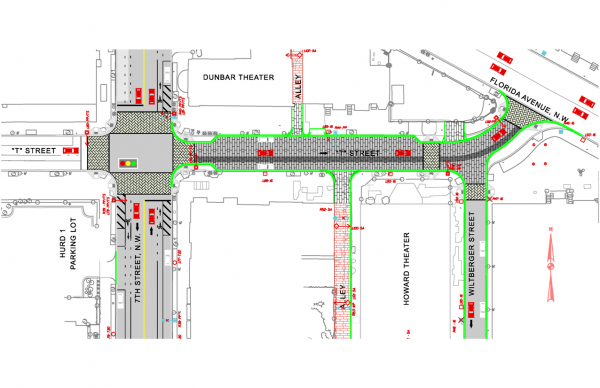
Below is the plaza section where T Street intersects Florida Avenue in front of Zenebech. Earlier today we noticed that the sculpture plinth is in place already. The deciduous tree will certainly be a welcome addition to what is now an uninterrupted expanse of concrete.


That was fast!

It was only earlier this year that work began on 1915 6th Street (right). The property stood as a vacant lot for years, but was snapped up by a condo developer.
After being on the market for just a few days at $299,000, the 1-bedroom, 1.5-bathroom basement condo at 1915 6th Street is now under contract.
LeDroit Park has seen a good deal of reinvestment over the past few years despite the economy. A new condo is nearing completion at 5th St and Oakdale Place (bottom left) after sitting as vacant lot for years. 1907 3rd Street (bottom right), after sitting as a vacant apartment building for many years, is now a condo building.
NPR reporter Ari Shapiro and his husband are renovating the old McGill house at 1922 3rd Street (below).

Howard still owns a few properties in LeDroit Park
In reviewing Howard University’s proposed campus plan, we started to take account of all of the property in DC that the university owns. Up until 10 years ago, Howard University was accused of being LeDroit Park’s biggest slumlord, owning numerous properties in the neighborhood and letting them lie vacant, blighted, and decaying.
Under the reign of university president H. Patrick Swygert, Howard made a significant and commendable effort to rehab and sell many of its vacant properties in the neighborhood.
For instance, the university owned all but one house on 400 block of Oakdale Place. It let these houses lie vacant, blighted, and boarded up. Under Pres. Swygert, the university renovated the houses and sold them to employees. Today the 400 block of Oakdale Place is fully occupied and a new condo building is nearing completion on the western end.
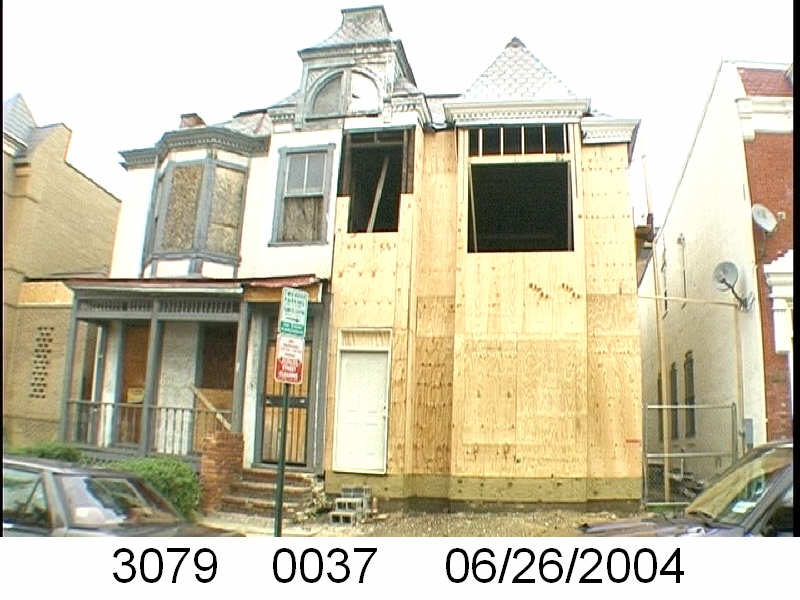
531 & 533 U St NW in 2004. Howard University renovated 531 (right) in 2004. Image from the DC government.
In other cases, the university renovated properties but has retained ownership. 531 U Street NW looked terrible in 2004 (right), but now looks very nice. We can’t quite tell if the house is occupied, but it consistently appears to be in good condition.
Elsewhere on the 500 and 600 blocks of U Street, Howard built historic infill houses (below) on vacant lots it owned on the north side of the street. The result is a block with with a continuous wall of housing on the street’s northern face. The houses’ façades are of high quality, with detailed brick work, ornate porches, and a variety of detailing.
The job is not entirely done, however, and Howard University retains ownership of a few properties that raise eyebrows. Let’s look at these three:
649 Florida Avenue (left) sits as a vacant lot, frequently collecting trash and debris. A university official told us that long ago Howard had considered using the lot to create a delightful pedestrian path to the university from the Shaw Metro. That never happened and now the lot sits vacant.
408-410 T Street (center) was the home of Walter Washington, DC’s first elected mayor. The university owns the property, and though it’s not blighted, it may be vacant. With some renovation work, this would make an excellent rental home for a Howard professor or anyone else for that matter.
326 T Street (right) is the Mary Church Terrell House, future home of the Robert and Mary Church Terrell House & LeDroit Park Museum and Cultural Center. Though it’s vacant and undoubtedly meets the District’s definition of blight, we are willing to cut the university more slack in this case since the eventual outcome will be a wonderful addition to the neighborhood. Unfortunately, the campus plan does not specify any additional Howard funding to restore the site.
In addition to the properties above, Howard owns a few more properties in LeDroit Park:
- Gravel parking lot at the SE corner of 5th and W Streets. (Square 3072, Lot 818). Campus plan does not mention any change to this lot.
- Carver Hall, 211 Elm St NW (Square 3084, Lot 830). Campus plan mentions the dorm’s decommission, but no reuse plans.
- Slowe Hall, 1919 3rd St NW (Square 3088, Lot 835). Campus plan mentions the dorm’s decommission, but no reuse plans.
- Howard University Hospital daycare, 1907-11 5th St NW (Square 3090, Lot 41)
- 420 T St NW – a house that appears to be occupied (Square 3094, Lot 800)
- Howard University Hospital (Square 3075, Lot 807)
- Parking garage bounded by 4th St, Oakdale Pl, 5th St, and V St. (Square 3080, Lot 73)
- Parking garage bounded by 4th St, V St, 5th St, and an alley. (Square 3072, Lot 52)
Though Howard retains a few problematic properties, it’s important to note the great strides the university has made in taking responsibility for its property portfolio in the neighborhood. A plan for these few remaining properties, even one in which the university retains ownership but leases, would put residents at greater ease.
Civic association conditions zoning support on vacancy
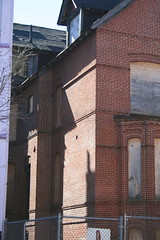 At Tuesday night’s meeting of the LeDroit Park Civic Association, the association voted 11-2 to support the Howard University Campus Plan. Since several issues in the plan remain unresolved and unspecified, your author voted against supporting it.
At Tuesday night’s meeting of the LeDroit Park Civic Association, the association voted 11-2 to support the Howard University Campus Plan. Since several issues in the plan remain unresolved and unspecified, your author voted against supporting it.
Among many concerns are the several vacant properties that Howard University owns in the area. Though Howard has made a commendable effort to refurbish and sell many of these properties in LeDroit Park over the past decade, we are worried that the university, after it moves students out of Slowe and Carver Halls might leave these two dormitories vacant for several years.
The university has been very adept at finding excuses for keeping several of its properties vacant in decades past.
For current vagueness in the plan, university officials say they haven’t determined a use yet or that they haven’t found the financing or that everything is the economy’s fault.
That may be true, but vacant buildings attract trouble. They become safe-havens for criminals, vagrants, and rodents. Some vacant properties become truly blighted with windows covered up with plywood or metal covers. This blight drags down property values and lowers the quality of life.
For most private property owners, vacant properties (class 3) face a steep 5% annual property tax and blighted buildings (class 4) face a 10% annual property tax. These punitive tax rates are meant to urge owners of vacant and blighted properties to return their properties to good order and productive use.
As a university, however, Howard pays no taxes on its land, so a punitive 5% or 10% tax on $0 is still $0 . As such, the neighborhood needs a legal mechanism to ensure the university does not vacate Slowe and Carver Halls and then blame the economy as they board up the buildings for several years.
Whether the university keeps the buildings as student dorms or converts them to faculty housing is fine either way, but vacancy and blight threatens the progress the neighborhood has made over the past decade.
To prevent this, your author moved “To amend our support [for the campus plan] to prohibit vacancy of Slowe and Carver Halls for more than one year.”
The motion was property seconded and passed unanimously.
The civic association will submit this language to the Zoning Commission and urge the commission to attach it to the legally enforceable order that ratifies the campus plan. This will ensure that these two large dormitories do not sit vacant for an unreasonable length of time over the next decade.
Howard University’s campus plan is an ambitious and mostly good plan, but it’s important that point out its shortcomings and to ensure the university does not get away with undue burdens on neighborhoods and the District.
Exemption from property taxes is a privilege, not a right, and residents are wise to ensure this exemption is not abused to the detriment of the public interest.
Get a rare glimpse of the McMillan Sand Filtration Site
This weekend we got a rare tour of the dormant McMillan Sand Filtration Site just north of Bloomingdale.
The site sits behind locked fences between North Capitol Street, Channing Street NW, 1st Street NW, and Michigan Avenue NW. The filtration site opened in 1905 to purify river water supplied to a burgeoning capital.
The filtration plant contains 25 acres of underground sand filtration cells. Water flows from the “castle” on McArthur Boulevard NW at the Georgetown Reservoir through an arrow-straight tunnel to the valve house on 4th Street at the McMillan Reservoir.
The reservoir opened in 1902 and is actually a dammed stream valley. Since the reservoir stores untreated river water, the water must be cleaned before it can be distributed to residents’ taps.
At the turn of the 20th century, a debate ensued between proponents of chemical purification and slow sand filtration. Slow sand filtration won the debate and Congress provided money to build the sand filtration cells.
The process of slow sand filtration is pretty simple. Water fills a cell that contains 2 feet of sand at the bottom— it’s like an underground beach.
The water percolates through the sand leaving contaminants behind in the sand. When the water reaches the floor under the sand, it exits the cell and is distributed into the city’s water pipes.
The sand itself required routine cleaning to remove the contiminants. Clean sand was stored in the concrete silos that stand in rows on the site.
Workers replenished the cells by dumping clean sand through the various access holes on the roof of each cell.
In fact, an early photo shows fresh sand dumped into a cell.
Regulator houses contained valves for regulating the flow of water through each cell.
The top of the filtration site was turned into a park, as envisioned by Sen. James McMillan (R – Michigan), famous for his ambitious McMillan Plan to beautify Washington.
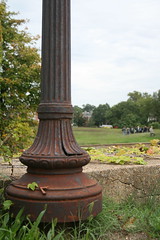 Frederick Law Olmsted, Jr., designed the park grounds on top of the sand filtration cells. Since the park closed to public access during World War II, the park’s recreational features, including green lawns, park lamps, walkways, and staircases, sit decaying today.
Frederick Law Olmsted, Jr., designed the park grounds on top of the sand filtration cells. Since the park closed to public access during World War II, the park’s recreational features, including green lawns, park lamps, walkways, and staircases, sit decaying today.
In the 1980s, the U.S. Army Corps of Engineers build a rapid sand filter on the part of the reservoir west of 1st Street NW, thus obviating the need for the slow sand filters east of 1st Street. The western section today holds the active open-air reservoir and rapid sand filters that supply clean water to much of Washington.
That section, which is still an active reservoir and water treatment plant, is closed to the public. What’s most unfortunate is that the western section contains the most notable feature of the reservoir park.
Shortly after Sen. McMillan’s death, Congress and donors in his home state of Michigan decided to honor the senator with an ornate fountain to adorn the park that bears his name.
The 1912 fountain, designed by Herbert Adams, contains a bronze sculpture of 3 nymphs on a pink granite base. In 1941 the fountain was dismantled, left in storage and mostly neglected until the top portion of the fountain was returned to Crispus Attucks Park in 1983. In 1992 the top section was moved to its current location, at the active reservoir site, locked away from public access.
One can still see the top portion of the fountain by glancing through the fence on 1st Street NW.
The base of the fountain remains somewhere in Fort Washington National Park in Prince George’s County. Perhaps someday the District, the federal government, and neighbors can raise the funds to reunite and restore the fountain for public enjoyment.
McMillan Site gets video tribute
Bloomingdale resident Snorre Wik has produced this video of the shuttered McMillan Sand Filtration Site.
Several months ago the city decided to reset development plans for the site and do part of the preliminary traffic and groundwater studies itself. We will keep you posted as development plans for the site inch along.
Howard faces dilemma with mixed-use development
Plans for Howard University’s proposed mixed-use development project, Howard Town Center, have been dragging on for years. The university is making the tough call to hold out for the ideal project rather than build what it can in this investment climate.
Troy Stovall, Howard University’s chief operating officer, revealed Thursday that the difficulty in financing the project is not due to the retail and supermarket component, but due to the number of apartments slated for the site.
Rather than letting the developer proceed with building the garage, supermarket, retail shops and half the number of apartments originally planned, Howard wants the full project, including all of the apartments built into project at the same time.
When asked on the status of the retail component, Mr. Stovall said that the developer has received several letters of intent from supermarkets interested in the space. The problem, though, lies upstairs. The banks, Mr. Stovall stated, are less convinced about the financial viability of building so many apartments on lower Georgia Avenue.
U street developer JBG, however, has recently purchased several properties within a few blocks of the Howard Town Center site. JBG and Howard’s banks clearly differ in confidence in the area’s potential.
Is Howard letting the perfect become the enemy of the good? Neighbors appear to strongly support the arrival of a supermarket, especially since the closest one, a mile away, offers a paltry selection.
However, to abide by the banks’ requirements to reduce the number of units reduces the viability of the area’s retail revitalization. More residents, after all, means more potential customers, and thus more chances for success along Georgia Avenue.
It’s certainly debatable as to whether the delay in the arrival of a grocery store is worth the slowing of Georgia Avenue’s revival. One the one hand, Howard’s desire for delayed gratification will make the avenue’s retail revitalization more durable. On the other hand, holding out for the ideal project postpones a catalyst for the avenue’s revival.



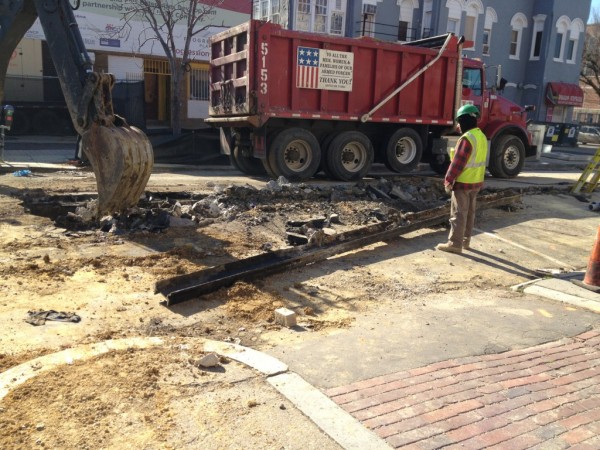



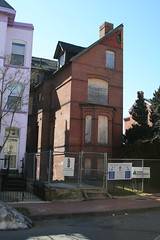
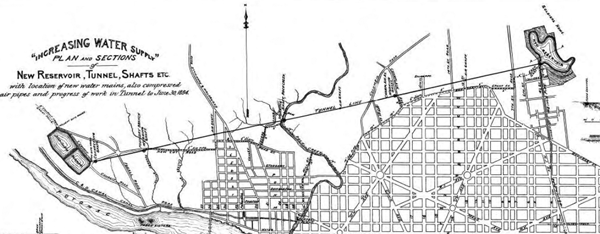
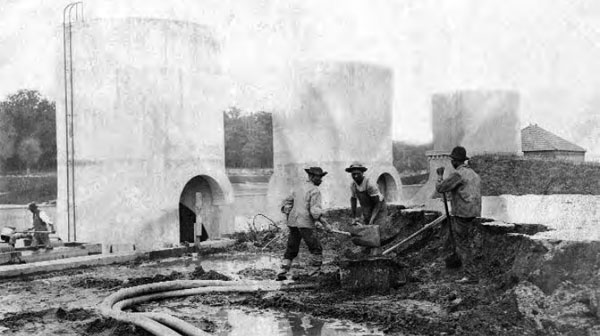
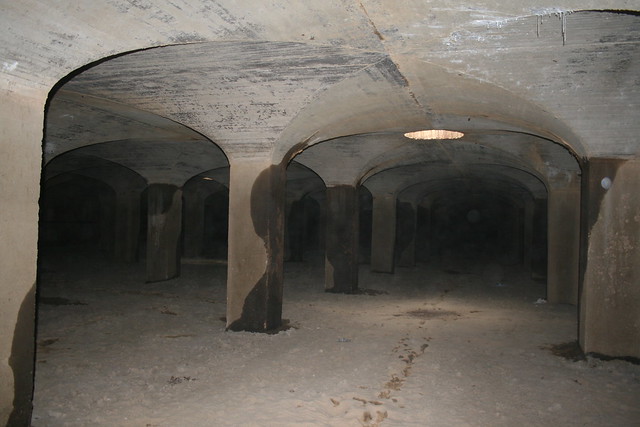
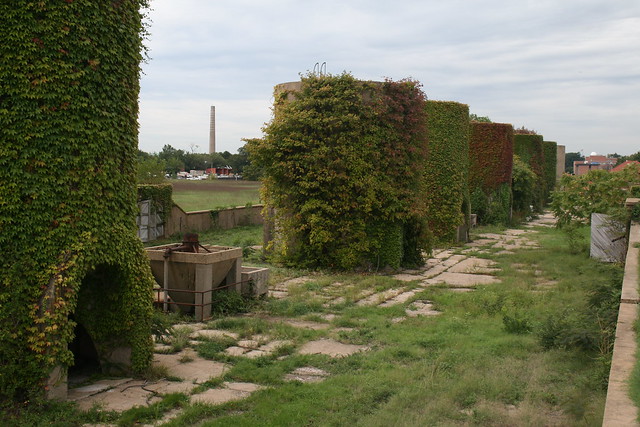
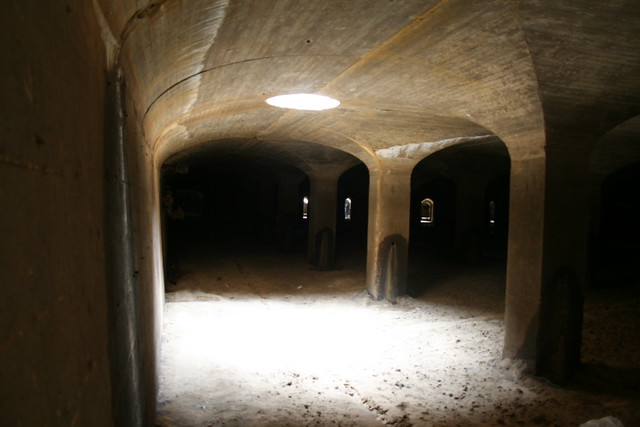
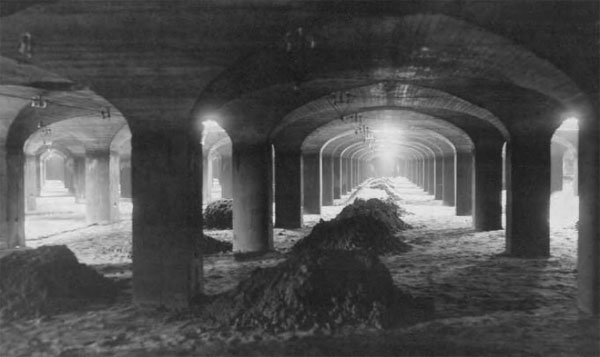

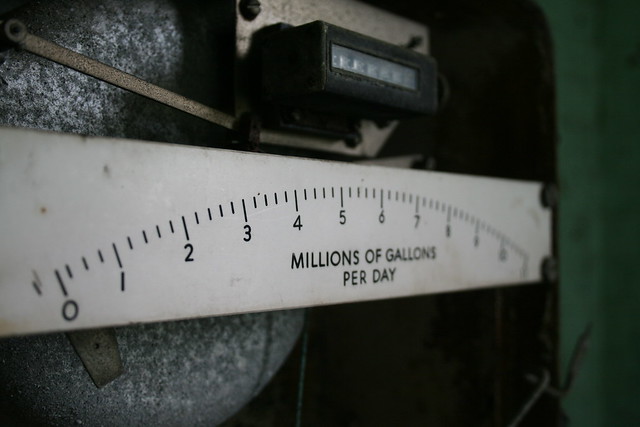
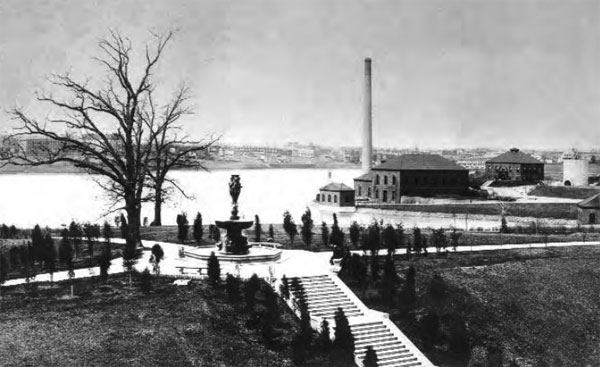

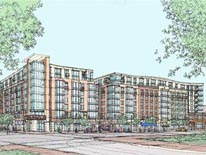






Recent Comments